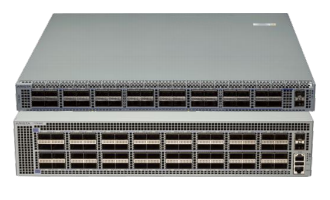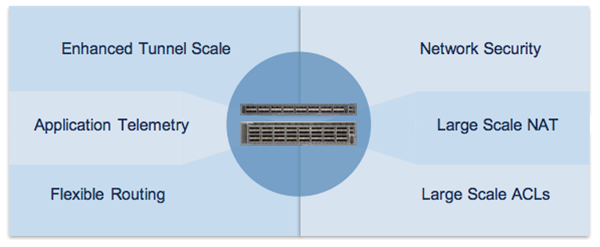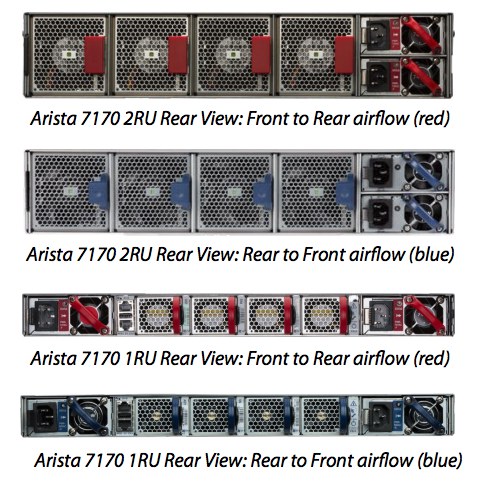
Quick Look
Arista 7170 Series Network Switch

Arista 7170 Series
High Performance
- Up to 12.8 Tbps System Capacity
- Up to 4.8 Billion Packets per Second
- Wire Speed Unicast & Multicast
- Class Leading Latency as Low as 800ns
- High Density 40G/100G
- Quad 10G and 25G or Dual 50G Modes
- 22MB Packet Buffer
- Under 5W per 100G Port
Feature Rich
- High Availability
- DC Optimized Airflow
- Rich L2 and L3 Features
- 64-Way MLAG
- 128-Way ECMP or UCMP
- Zero Touch Provisioning
- Smart System Upgrade *
- Hitless MLAG ISSU
- Large Scale NAT *
- AlgoMatch for Network Policy
System Scalability
- Wirespeed L2 and L3 Forwarding
- 64 x 100G or 40G with Optics and Cables
- Up to 256 x 25G or 10G or 128 x 50G using Breakout Cables
- Scalable MAC & IPv4 Hosts and Routes
- Wirespeed Network Address Translation
Advanced Monitoring
- CloudVision
- LANZ Microburst Detection *
- AEM Proactive Management
- IEEE 1588 Precision Timing *
- sFlow for Network Visibility *
- VM Tracer Integration
- Advanced Telemetry with Packet Traces and User-defined Triggers
* = Not currently supported in EOS
Arista 7170 Series Introduction
Highly dynamic cloud data center networks continue to evolve with the introduction of new protocols and server technologies. The Arista 7170 series are purpose built, programmable fixed configuration data center switches for flexible, dense 100GbE solutions at spine layer and 25/50GbE solutions for storage and compute.
Combining Arista EOS and a highly programmable switch architecture with customizable system resources, the 7170 Series delivers unique features for traditional and new network based applications and services.
7170 Series Deployment Scenarios
With 32 and 64 port QSFP100 port fixed configuration systems in compact form factors, the 7170 series are 100GbE systems that can support a flexible combination of up to 64x 40/100GbE, 128x 50GbE or 256x 10/25GbE of wire speed performance powered by Arista EOS, the worlds most advanced network operating system.
The 7170 series supports a unique programmable pipeline with the flexibility to change the packet parser dynamically through profiles defined in P4, to add new functionality, vary table sizes and order of operations. This provides phenomenal investment protection along with opening the possibility to support highly personalized use cases to solve traditional and new network challenges which are otherwise not feasible with traditional switching platforms. The following are a selection of such use cases
-
Network Services Offload
in a bare metal environment freeing up compute resources and accelerating applications. -
Tunnel Termination
in a multi-tenant design. -
Large Scale NAT
for address and port translation. -
Flexible Routing
to support MPLS label modification or custom protocols. -
Network and Application Telemetry
with flow level visibility, timestamping and end to end latency measurement. -
Network Security
with stateful and hierarchical ACLs, rule based policies, and conditional filtering for enhanced security and application monitoring.

Arista EOS
Arista EOS is a modular switch operating system with a unique state sharing architecture that cleanly separates switch state from protocol processing and application logic. Built on top of a standard Linux kernel, all EOS processes run in their own protected memory space and exchange state through an in-memory database. This multi-process state sharing architecture provides the foundation.
7170 Series Systems
Arista 7170 Series support hot-swappable power supplies and N+1 fan redundancy, EOS high availability, a choice of L2 and L3 multi-pathing designs and powerful EOS innovations for visibility, network security, application level performance monitoring and virtualization.
Feature |
Description |
|---|---|
CloudVision |
Network-wide workflow automation and workload orchestration as a turnkey solution for Cloud Networking |
Smart System Upgrade* |
Optimized SW upgrades to reduce the impact of software upgrades and avoid network convergence |
Hitless Speed Changes |
Eliminate downtime when configuring different speeds and bringing up new links |
128 way ECMP and 64 way MLAG |
Improve network scalability and balance traffic across large-scale leaf-spine designs or server load balancers |
Programmable Packet Processor |
Multi-stage pipeline which allows reconfiguration of the packet forwarding logic programmatically |
Flexible Resource Profiles |
Flexible allocation of L2 and L3 forwarding table resources for greater design choice. New profiles implemented via EOS |
Network Telemetry |
Identify application performance in real time by parsing packets, combining flow and packet level information and exporting for analysis |
IEEE 25GbE 802.3by |
IEEE standard ensuring interoperability, long reach optics and long term investment protection |
Packet Timestamping |
Monitor end to end network performance with accuracy |
Large Scale NAT* |
Network Address translation with no performance impact to resolve overlapping addressing challenges |
* = Not currently supported in EOS
7170-64C |
7170-32C |
|
|---|---|---|
| Description | 64-Port QSFP100 and 2 SFP+ |
32-Port QSFP100 and 2 SFP+ |
| Maximum 100G Ports | 64 | 32 |
| Maximum 40G Ports | 64 | 32 |
| Maximum 10G Ports | 258 | 130 |
| Maximum 25G Ports | 256 | 128 |
| Maximum 50G Ports | 128 | 64 |
| Maximum System Throughput | 12.8Tbps | 6.4Tbps |
| Maximum Forwarding Rate | 4.8Bpps | 2.4Bpps |
| Port to Port Latency | 800ns | 800ns |
| Total System Buffer | 22MB | 22MB |
| Typical Power per Port | 5W | 7W |
| Airflow | Front-Rear or Rear-Front |
Front-Rear or Rear-Front |
High Availability
- 1+1 Hot-Swappable Power Supplies
- Four N+1 Hot-Swap Fans
- Color Coded PSU's and Fans

